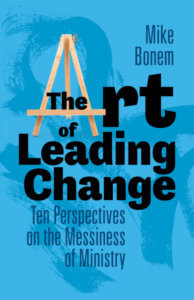How can you lead effectively given the inherent messiness of congregational life? Ann Michel of the Lewis Center staff interviews leadership expert Mike Bonem on the art of leading change, responding to those who resist change, and the courage to allow yourself to be changed.
Listen to this interview, watch the interview video on YouTube, or continue reading.
Ann Michel: In your new book, The Art of Leading Change, you write that “the work of leading change in the church is always messy.” Can you elaborate on that theme?
Mike Bonem: I think most church leaders will immediately identify with that idea because leadership is all about people, and people come into the life of the church in all sorts of different ways. Some of them are ready for change. Some of them are reluctant to change. Some of them are deeply invested in the work of the church. Some are not. Some are very mature believers. Some are not. They bring all of that and whatever past experiences they may have had with the church into the current context. And that just makes for a pretty messy leadership equation particularly when we’re talking about change.
Ann Michel: You say that leadership is inherently messy, but you also outline a perspective on change that’s quite thoughtful, deliberate, and planned. That struck me as somewhat paradoxical. Can change be orderly and purposeful and messy at the same time?
Mike Bonem: Yes, I think so. I don’t suggest that we can just eliminate messiness. But I’m trying to provide some tools to make it a bit more orderly, a bit less messy, and to allow leaders to see ways to make progress through the mess.
Ann Michel: Throughout the book you use the metaphor of art, such as painting and sculpting, to illustrate how something can be both messy and purposeful at the same time.
Mike Bonem: My favorite example relates to sculpting. If you are a sculptor, especially if you are working with any kind of stone, it is inherently messy. You’re chipping away. You’re creating dust. You can’t do that work without ending up just covered in what you’ve chipped away. But it’s important to know exactly when and how to chip away, what to work on, what not to work on, when to step back and say the work is finished, at least for now. I think that’s all instructive from a leadership standpoint.
Ann Michel: This is why you say change is an art and not a science.
Mike Bonem: Exactly. My first book, Leading Congregational Change, which I coauthored with a couple of friends, focused more on the “science” or process of leading change. And it can appear very straightforward and linear, very clean and nice, very neat and orderly. My reason for coming back to the subject in The Art of Leading Change was to recognize just how messy the leadership task can be, to step away from some of that “science” and delve into the complexities always involved in leading change.
Ann Michel: Some leaders think the best way to promote change is just to stir the pot and upset the equilibrium of a system. And I think we’ve all been in situations where a mess is just a mess and not a good thing. So, is there a tipping point? Is there a point at which messiness becomes irredeemable or insurmountable rather than an expected part of the process?
Mike Bonem: That’s a great observation. I agree that we can go too far and that things can become too messy. Sometimes a mess is just a mess. Part of the answer to your question relates to the first chapter in my book, “Lead with Trust.” Our ability to lead and even stir things up is highly dependent on how much people trust us or at least our ability to lead well in those situations. Someone who just comes in and stirs the pot but doesn’t have that relational capital is very likely to create what you referred to as an irredeemable mess.
If you look around and people aren’t following or if you have a great idea but people aren’t excited about it, it’s often because you haven’t invested in the relational capital or you’ve drawn down the relational capital too much. In Canoeing the Mountains, Tod Bolsinger says “without trust there is no travel.” And that’s a really helpful phrase. If people don’t trust you enough, they’re not going on a change journey with you.
Ann Michel: Can you share some advice on how to deal with people who oppose or resist change?
Mike Bonem: “Resisters Are Not the Enemy” is the title of one chapter in my book. And it was probably this idea as much as anything that compelled me to write the book. Our society is so polarized. And I deeply believe the church should be an example of how we can act differently, how we can sit in pews and in classes and in small groups with people who think differently and not immediately label them as the enemy. And yet, unfortunately, a lot of those societal trends have crept into the church.
Someone who questions a new idea or even registers some kind of resistance isn’t the enemy. In my experience, when someone is voicing some level of opposition it’s not because they’re an inherently evil person. They’re not voicing that opposition because they want to tear down the church. Maybe they really aren’t convinced of the rightness of the idea. Or maybe they are afraid. Sometimes they see something very different than what the leader sees, and it’s important to consider their view. But none of those things make them an enemy. Rather than reacting by trying to exclude resisters and potentially even divide the church in the process, you have a much better chance of forging a path forward that includes them if you can really listen to opposing ideas and embrace the human being behind them.
Ann Michel: But you also say that leaders can’t fall into the trap of trying to please everybody.
Mike Bonem: Yes. It’s really two sides of the same coin, isn’t it? In my two decades of work with ministry leaders, I have found that a disproportionate tend to be “people pleasers.” They want to keep everybody happy. But trying to get everybody on board can be dangerous. If we wait until there is 100 percent support for a significant change, we end up waiting an inordinately long time or we really water down the idea and end up with the lowest common denominator. Neither of these is what God would want us to do. Waiting to get everybody on board sets us up for a lot of disappointment and very little progress.
Ann Michel: I find that a lot of church leaders are paralyzed by the false notion that a consensus requires that one hundred percent of people agree with a decision. Can you explain the difference between consensus and unanimity?
Mike Bonem: In my consulting work, I’m often surprised by how many people equate consensus and unanimity. From a dictionary standpoint, they do not mean the same thing. But consensus is difficult for some people because it’s sort of a mushy term. It’s not just a majority. So, what is it?
I think consensus is a great spiritual concept. If you look at the Jerusalem Counsel in Acts 15, they ultimately conclude that not requiring Gentile believers to adhere to all the Jewish practices “seemed right to the Holy Spirit and to us.” It doesn’t say it was unanimous. It doesn’t say they took a vote. It says, “it seemed right.” And I think that’s a model of consensus. We don’t necessarily vote. We don’t necessarily wait for unanimity. But does it seem right to the Holy Spirit and to us? That can be a little mushy and a little unclear. What percentage of people is that? Is it a two-thirds supermajority? No, it’s consensus.
Ann Michel: Your discussion of leading change assumes a particular model of change that begins with a leader; the leader then gets the approval of other key leaders; then the leader communicates the change more broadly; and then they recruit other people to implement the change. In my experience, at least, change don’t necessarily start with one key leader. Sometimes it bubbles up in more decentralized, organic, bottom-up ways. Can you speak to this dynamic?
Mike Bonem: I appreciate your observation. I do think pastors are in a unique role in their leadership of the church. Years ago, George Barna observed that many pastors did not have the gift of leadership and proposed letting them use the gifts they have and letting other people lead. I thought that was a fairly insufficient and shortsighted observation because people do look to the pastor to provide significant leadership. Having said that, I do not believe in a kind of “Moses model” of pastor who goes to the mountaintop, hears God’s vision, comes down to tell all the people, and expects them to follow. That’s not at all what I’m trying to communicate in the book. But pastors spend a lot of time thinking about the issues in the church and have some unique insights about how to lead it.
But I don’t believe in a purely top-down model of leadership at all. The chapter in my book entitled “Heavy Loads Require Strong Teams” is geared toward a more collaborative style of leadership that involves seeking the input of others in deciding the direction and the right steps forward and enlisting their support in making that happen.
Ann Michel: Has the experience of the pandemic changed your understanding of how change happens in churches? So many churches were really forced to adopt new practices almost overnight.
Mike Bonem: In the first year or so of the pandemic, I thought we were going to have a great opportunity to do some pretty fundamental rethinking of leadership in churches. How would we be church? What would that look like going forward? But over the last 12 months, I’ve sensed that a lot of the energy and creativity around doing things differently has been overwhelmed by concern about the people who aren’t coming back, or what the budget looks like, or by the desire to go back to the way it was before the pandemic. So, I fear we’re missing or have missed an opportunity to do some deeper rethinking.
The first few months of the pandemic proved that we could be nimble at a tactical level. Even small churches that I never thought could do something online adapted really well in that respect. But right now, I don’t see a lot of churches doing the deeper work that would ultimately help them engage more effectively with their community — thinking differently about how to reach people that are not coming to church, thinking about how to connect with people for whom the pandemic was really a deep soul-shaking experience but who don’t identify as Christian. I wish they would.
There’s no question that a disruption, whether it’s a global disruption like a pandemic or very localized disruption in the community around the church or in the church itself, can be a great catalyst for change. I don’t know when we say the pandemic is officially over, but it’s not disrupting life in the church today the way it was two-and-a-half years ago. And I think because that disruption is mostly in the past, the question people are asking now is “how do we get back to the way it was?” as opposed to “how do we embrace some sort of new normal?”
Ann Michel: In the conclusion of your book, you say that someone can’t lead change in an organization without the courage to open themselves up to personal change, as well. Why is that the case?
Mike Bonem: We can think about all these issues of leading congregational and corporate change, but ultimately it comes back to our willingness to change ourselves. And it’s a spiritual process. The change needs to begin with us. And our change needs to be driven by what God is doing in our lives.
The people in our churches are smart. They’re going to be much more resistant to change if they sense a leader is trying to dictate change from on high but is unwilling to make changes themselves, if they sense that kind of spiritual work is not going on in the life of the leader, if they sense that God is not shaping and changing that leader. So, I think it’s critically important.
And this relates back to the question of inclusivity in leadership because a leader opens him or herself up to personal change by listening to others and including people on the team who may have differing views.
Ann Michel: If a new church leader came to you for advice on how to get started or what first steps to take, what would you suggest?
Mike Bonem: I would probably ask a lot more questions before I would give advice, because good advice is always specific to who the leader is and the context in which they are serving. But having said that, the thing that immediately comes to mind is scheduling some time away. Go to your favorite retreat setting. Spend some time reflecting on your own leadership, listening to God, and getting as much clarity as you can. I think we have to ask the question, “God, what changes do I need to make to lead well?” The congregational change journey I’m talking about needs to be Spirit-led.
I lot of us have bought into the idea of constant busyness. My worth is defined by how busy I am. Being incredibly busy is seen as a badge of leadership success. And that means we don’t have time to listen to God and to let God do the transforming work that God wants to do in our own lives. So, the one piece of advice I might give is to spend that time away and see where God takes you. And then the second is to start to get some people around you who do not always agree with you but who are at least equally open to where God might be leading the church and who would explore that with you.
 Related Resources
Related Resources
- The Art of Leading Change: Ten Perspectives on the Messiness of Ministry (Fortress Press, 2022) by Mike Bonem, available from the publisher and at Cokesbury and Amazon
- Discovering God’s Future for Your Church Video Tool Kit
- The Art of Forging a Meaningful Consensus by Ann A. Michel
- 8 Factors that Make You a More Influential Leader by Doug Powe
- Leaders Learn to Work with Difficult People by Ann A. Michel







